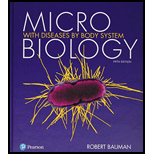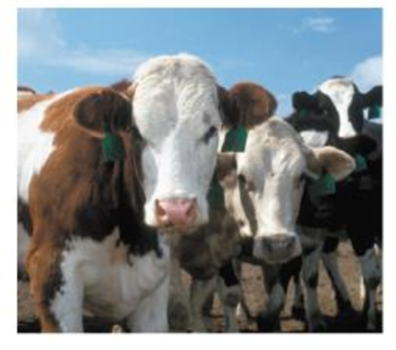
Variant Creutzfeldt-Jakob Disease

Ellen screamed obscenities as she staggered from the room and collapsed in the hallway, jerking uncontrollably and unable to stand. Her parents were shocked that their kind, considerate, and lovable daughter had changed so drastically during the past year. Sadly, she couldn't even remember her siblings’ names.
Ellen had joined the nearly 200 people afflicted with variant Creutzfeldt-Jakob disease (vCJD; what the media call “mad cow disease” because most humans with the condition acquired the pathogen from eating infected beef). Because vCJD affects the brain by slowly eroding nervous tissue and leaving the brain full of spongelike holes, the signs and symptoms of vCJD are neurological. Ellen's disease started with insomnia, depression, and confusion, but eventually it led to uncontrollable emotional and verbal outbursts, inability to coordinate movements, coma, and death. Typically, the disease lasts about a year, and there is no treatment.

Variant CJD resembles the rare genetic disorder Creutzfeldt-Jakob disease (named for its discoverers), which is caused by a mutation and occurs in the elderly. The difference is that the variant form of CJD results from an acquired infection and often strikes and kills college-aged people, like Ellen in our story. For more about vCJD, see pp. 621-623.
- 1. The vCJD pathogen is primarily transmitted when a person or animal consumes nervous tissue (brains). How could cattle become infected?
- 2. Why is vCJD called variant?
- 3. What effect does this pathogen have on cattle?
Want to see the full answer?
Check out a sample textbook solution
Chapter 1 Solutions
Pearson eText Bauman Microbiology with Diseases by Body Systems -- Instant Access (Pearson+)
- Identify the indicated cavity (Fucus). a. antheridia b. conceptacel c. receptacle d. oogonium e. none of thesearrow_forwardIdentify the indicated structure (Saprolegnia). a. antheridium O b. oospore c.sperm d. auxospore e. tetraspore Of. zygosporearrow_forwardUsing information from the primary literature (several references have been provided as a starting point below) please answer the following question: Based on your review of the literature on rewilding, what are the major scientific pros and cons for rewilding? Please note that the focus of this assignment are the (biological) scientific issues associated with rewilding. As will be discussed in class, there are a number of non-scientific issues involved or implicated in rewilding, all ultimately affecting the public acceptability of rewilding. Although these issues are important – indeed, critical – in this assignment you should focus on the biological science issues and questions. Details: You must enumerate at least two pros and at least two cons. Your answer should be no more than 500 well-chosen words, excluding references. Think carefully about how best to organize and structure your answer. Aim for high information density: say a lot, but say it succinctly. Recall Nietzche’s…arrow_forward
- Using information from the primary literature (several references have been provided as a starting point below) please answer the following question: Based on your review of the literature on rewilding, what are the major scientific pros and cons for rewilding? Please note that the focus of this assignment are the (biological) scientific issues associated with rewilding. As will be discussed in class, there are a number of non-scientific issues involved or implicated in rewilding, all ultimately affecting the public acceptability of rewilding. Although these issues are important – indeed, critical – in this assignment you should focus on the biological science issues and questions. Details: You must enumerate at least two pros and at least two cons. Your answer should be no more than 500 well-chosen words, excluding references. Think carefully about how best to organize and structure your answer. Aim for high information density: say a lot, but say it succinctly. Recall Nietzche’s…arrow_forwardNow draw a rough sketch of what the control data might look like if in addition to the specific binding, there was also a considerable amount of nonspecific binding (again using a normal dose/response curve) (do % total bound ligand vs concentration)arrow_forwardWhat are functions of cuboidal cells in the kidney? Select all that apply. Concentration of gases Dilution of chemicals Secretion of molecules Nutrition to tissues Support of tissues Absorption of moleculesarrow_forward
- question1 In plants, epithelial tissue is only found as the outermost cell layer and acts as a barrier. In humans, epithelial tissue is found inside the body as well as on the surface. What function(s) does/do epithelial tissue carry out in humans? Select all that apply. Waste storage Filtration Oxygen transport Protection Diffusion Osmosis Absorptionarrow_forwardWhat words best describes this organism? a. Unicellular/nonmotile Ob. unicellular/motile c. colonial/nonmotile d. colonial/motile e. multicelluar O f. siphonous g. none of thesearrow_forwardIdentify the phylum or class. a. Euglenophyta b. Dinoflagellata c. Bacillariophyceae d. Oomycetes e. Phaeophyceae O f. Myxomycota g. Xanthophyceae ○ h. Chrysophyceae i. Dictyosteliomycota O j. Rhodophyta Ok. Chlorophyceaens I. Charophyceaensarrow_forward
 Medical Terminology for Health Professions, Spira...Health & NutritionISBN:9781305634350Author:Ann Ehrlich, Carol L. Schroeder, Laura Ehrlich, Katrina A. SchroederPublisher:Cengage Learning
Medical Terminology for Health Professions, Spira...Health & NutritionISBN:9781305634350Author:Ann Ehrlich, Carol L. Schroeder, Laura Ehrlich, Katrina A. SchroederPublisher:Cengage Learning- Understanding Health Insurance: A Guide to Billin...Health & NutritionISBN:9781337679480Author:GREENPublisher:Cengage





